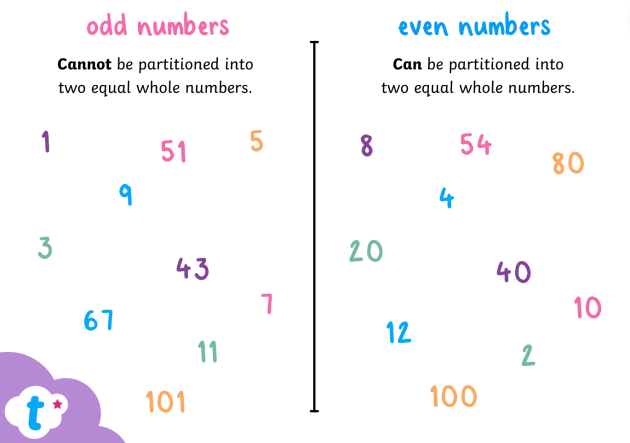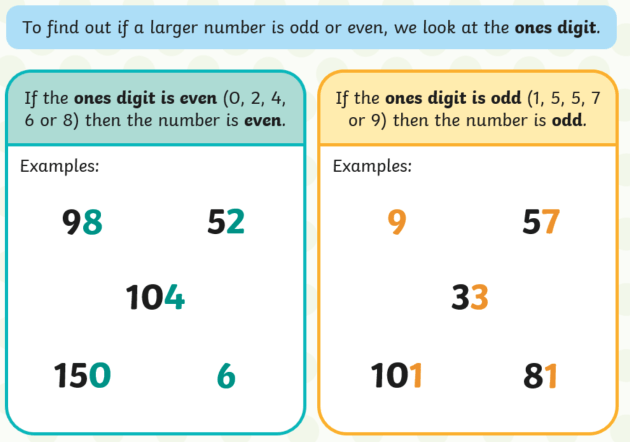

Odd numbers cannot be partitioned into two equal whole numbers.
Even numbers can be partitioned into two equal whole numbers.

Odd numbers cannot be partitioned into two equal integers. For example, three can be partitioned into a group of one and a group of two. As these groups are not equal, three is an odd number. Odd numbers are not divisible by two.
Even numbers can be partitioned into two equal integers. For example, four can be partitioned into two groups of two. As these are equal groups of whole numbers, four is an even number. Even numbers are divisible by two, with no remainders.
Odd numbers have a ones digit of 1, 3, 5, 7 or 9. For example, 21 and 4751 are both odd numbers because they both have 1 in the ones position.
Even numbers have a ones digit of 0, 2, 4, 6 or 8. For example, 74 and 2914 are both even numbers because they both have 4 in the ones position. Even numbers are always multiples of two because they can be partitioned into two equal groups of whole numbers.

|
The principal focus of mathematics teaching in key stage 1 is to ensure that pupils develop confidence and mental fluency with whole numbers, counting and place value. For more information or guidance, please see the national curriculum in England: mathematics programmes of study. |
Year 1: Number – Number and Place Value
Non-Statutory Guidance:
Year 2: Number – Multiplication and Division
Pupils should be taught to:
Children initially start to explore odd and even numbers within ten. The non-statutory guidance suggests activities that develop children’s recognition of patterns in the number system. Children can start by sorting objects into two groups to identify odd and even numbers and then progress to visual representations of odd and even numbers. For example, placing counters or images onto a ten-frame in a systematic way can help children identify and understand whether a number is odd or even. In the example below, you can see images of people placed on a ten-frame.

Children can learn to identify odd and even numbers using a number line. They will notice the pattern that alternate numbers are odd and even.

They can also learn to use a 100 square to identify odd and even numbers.
Children will learn that numbers with a ones digit of 0, 2, 4, 6, 8 will always be an even number, whereas numbers with a ones digit of 1, 3, 5, 7, 9 will always be an odd number. Using this knowledge, children will learn to identify larger odd and even numbers and sort them accordingly.

 Home
Home  Membership
Membership  Customer Support
Customer Support  Create
Create  Blog
Blog 























